by Tom Gaylord
Writing as B.B. Pelletier
Sig Sauer MPX.
This report covers:
- How to load the MPX
- Orient the magazine by the magazine door
- Removing the belt
- Load the belt
- Feeding the belt into the magazine
- Sig Sauer Match Ballistic Alloy pellets
- Crosman SSP pellets
- Air Arms Falcon domes
- Does firing fast lower the velocity?
- Shot count
- Trigger
- Evaluation so far
Today we will look at the velocity of the MPX from Sig Sauer. I called it a sub-machinegun in Part 1 and a reader pointed out that subguns are full-auto. This one isn’t, so I erred in using that term. Sig doesn’t use it anywhere. They call it a semi-automatic air rifle, which is correct. I will use that term from this point on.
How to load the MPX
Today is the day we look at velocity, but before we do that, I told you I was going to rewrite the magazine loading instructions, to make them clearer. The manual doesn’t distinguish what is right and left in the instructions, yet they refer to the left and always feeding the magazine from a clockwise direction. Unless the owner knows how to orient the magazine, left, right and clockwise have no meaning.
Orient the magazine by the magazine door
There is a door on one side of the magazine. If you open this door and hold the magazine in your left hand so the open door points to your left, the magazine will be correctly oriented for everything I am about to say.
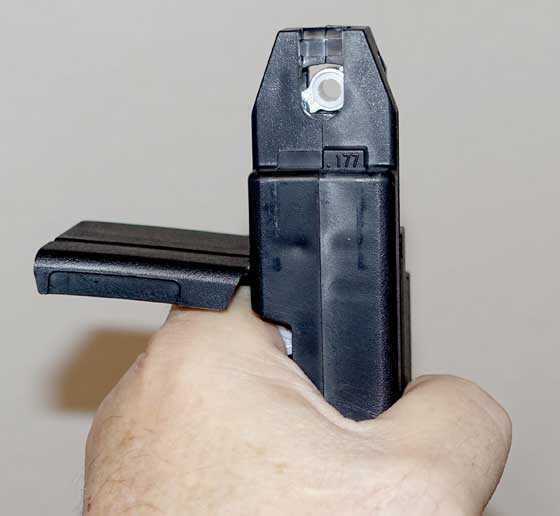
If you hold the MPX magazine in your left hand like this, everything that follows will make sense.
The belt is now accessible through the open door on the left side of the magazine. If you push up on the belt, it will rotate freely in a clockwise direction from your point of view. This is the only safe direction to move the belt. The manual warns that belt movement in the other direction can damage the magazine. As the gun fires and feeds, this is the direction the belt moves.
Removing the belt
The belt ends with two black pellet chambers on either end. Move the belt around in the magazine clockwise until these 4 black chambers are seen in the open door. Pick the bottom 2 black chambers out of the magazine and pull the entire belt out. It should move easily and freely. Now you can load the belt.
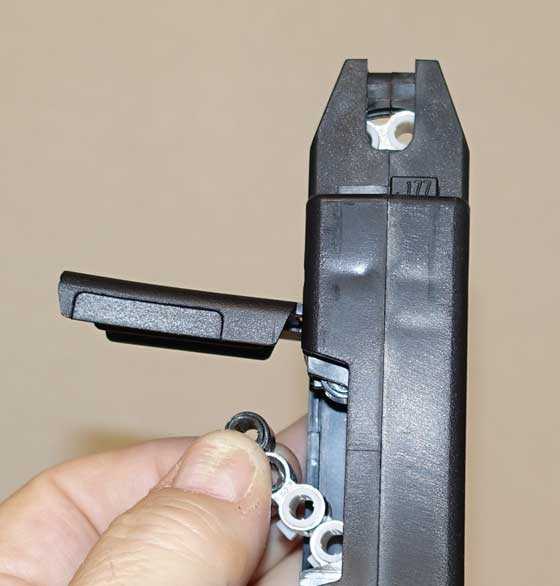
Pull the belt out of the magazine from the bottom, like this. This keeps the belt moving in a clockwise direction that won’t damage the magazine.
Load the belt
Place the belt on a table with the metal ends of the chambers on the bottom. Insert a pellet, nose-first into the top of each chamber and press it flush with your thumb or finger. Once the belt is loaded (all chambers do not have to be loaded for the gun to function) use the pellet seating tool provided with the gun to push each pellet as deep into the chamber as it will go. The tool will stop at the correct depth. When all pellets are seated the belt can be fed into the magazine.
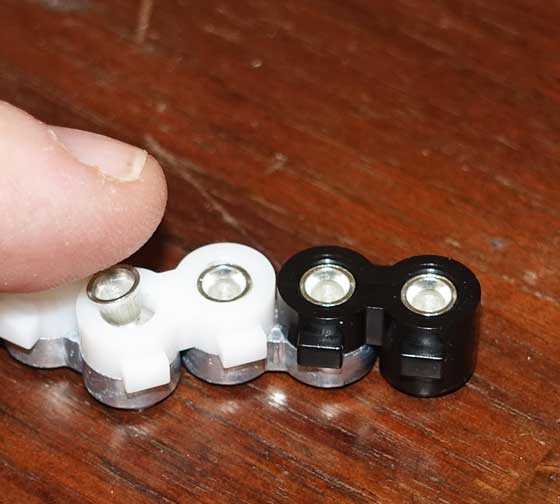
Insert a pellet into each chamber of the belt and press flush with a finger.
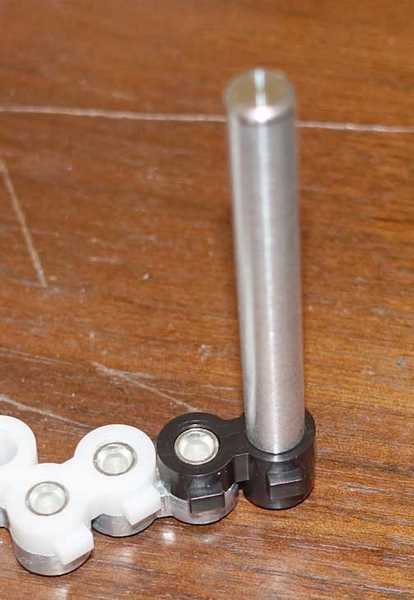
Used the seating tool to press each pellet as deep into the chambers as they will go.
Feeding the belt into the magazine
The belt can only be inserted one way. Hold the end of the belt in your left hand with the metal portion of the chambers facing you and the tabs of each chamber pointing to the left. This is the way to insert the belt into the magazine.
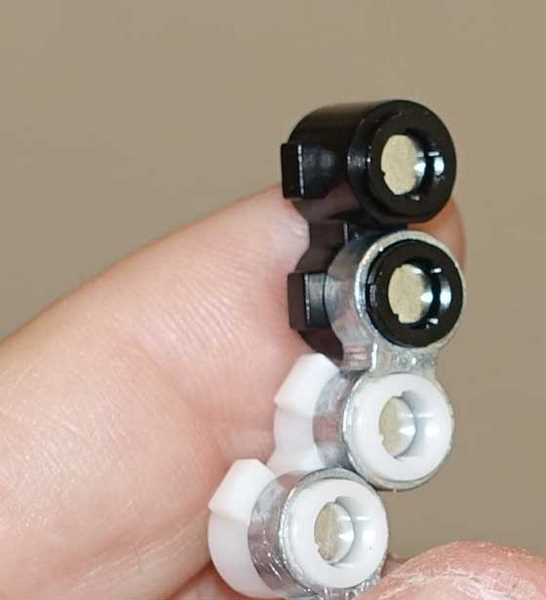
Hold the belt in your left hand with the chamber tabs pointing to the left and the metal portion of each chamber facing you, like this.
Now pick up and hold the magazine in the same orientation as before — with the door open to the left. Insert the belt and push it upwards, into the magazine. It will go in easily once the tabs align with the clearance track in the magazine. Keep pushing the belt up and watch it go over the top of the mag in a clockwise direction as it is fed in. When the entire belt is in the magazine you can always rotate it in this same clockwise direction at any time.
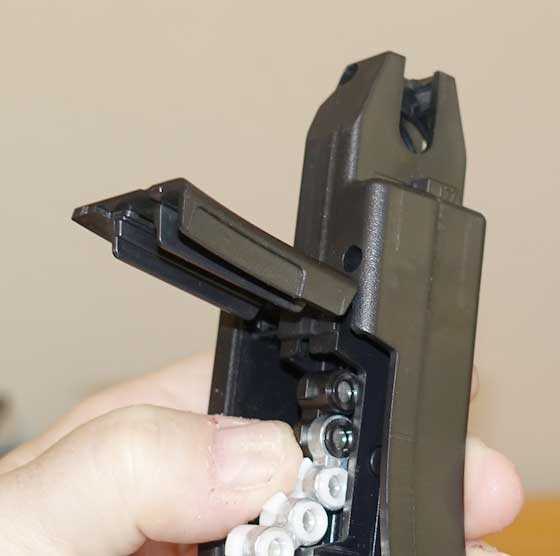
Insert the belt into the magazine with the tabs to the left like this. Push the belt in and up, so it goes over the top of the magazine in a clockwise direction. It should feed easliy once the tabs are aligned with the magazine raceway.
That is how to load the belt and also how to both remove it and insert it back into the magazine. Once you get the hang of it, you won’t have to follow these steps exactly as they have been described. This is just to get you up and running at the start. Now we’ll look at the velocity. For the first part of the test I waited a minimum of 10 second between each shot to let the gun warm back up. The room was 70 degrees F when these tests were conducted.
Sig Sauer Match Ballistic Alloy pellets
I started the test with Sig Sauer Match Ballistic Alloy pellets that weigh 5.25 grains. They fit the chambwers of the belt very tight. They averaged 532 f.p.s., with a spread than went from 525 f.p.s. up to 540 f.p.s. That’s pretty tight for a CO2 action airgun, but the velocity is lower than the advertised 600 f.p.s.
Crosman SSP pellets
To give the MPX every opportunity to achieve its advertised velocity I next loaded 10 Crosman SSP pellets. These lead-free pellets weigh 4.0 grains and seated in the chambers much easier than the Sig pellets. They averaged 598 f.p.s. with a spread from 581 to 608 f.p.s. 4 shots were above 600 f.p.s., so the MPX certainly does meet the advertised velocity of 600 f.p.s. It only does so with lightweight pellets, but you have to understand that advertised velocity is for product liability purposes. It represents the top velocity the gun can achieve. You may not think that way, but a company selling airguns has to, because they might have to defend their product in court someday (i.e. how dangerous it is, should it be used by adults only, etc?).
Air Arms Falcon domes
To get a realistic idea of the velocity using real-world pellets that an owner might select, I tried the Air Arms Falcon domed pellet. This 7.33-grain dome is light weight and made from pure lead. It’s usually very accurate in most lower-powered airguns.
In the MPX Falcons averaged 471 f.p.s. with a spread from 461 to 489 f.p.s. This is the sort of velocity that can be expected from the airgun on an everyday basis.
Does firing fast lower the velocity?
Next I wanted to see how shooting very rapidly affects the velocity. You know that’s what owners are going to do. So I loaded 4 Crosman SSP pellets. I fired the first one to see if it was still in the same range and it registered 598 f.p.s. Then I removed the magazine and dry-fired the gun 30 times to chill it. When that was finished the gun felt colder to the touch. Then I inserted the magazine and shot the next 3 SSP pellets with a 3-second pause between shots. The velocities were:
538
541
568
What this shows is the gun does slow down when fired rapidly, but it also recovers quickly. From what I see there shouldn’t be a problem firing as fast as you want — especially on warm days.
Shot count
I know everyone wanted to know how many shots to expect from one of those 90-gram CO2 cartridges. I was using a cylinder provided by Sig Sauer, but Pyramyd AIR doesn’t carry them, so I linked to a cartridge they do carry. The results should be pretty similar, as these cylinders are all filled to the same standards, though each one will vary from all others by slight amounts.
To test the shot count I loaded a belt with SSP pellets, then shot the first one for a test of the remaining power. The velocity was 583 f.p.s., which is about where it should be.
Then I removed the magazine and fired 50 blank shots as fast as I could pull the trigger. The gun was very cold after this, so I let it warm up for about 5 minutes. Then I inserted the magazine and fired the 118th shot on this CO2 cylinder. It went out the muzzle at 554 f.p.s. I can’t be sure the gun was fully warmed up after the 50 shots, but this does simulate shooting the gun a lot at one time.
Then I removed the magazine and fired another 50 blank shots. After another 5-minute rest to warm the gun I inserted the magazine and fired shot number 169 It went out at 500 f.p.s. I also noticed there was no fog of CO2 issuing from the empty magazine port about halfway through the 50 blank shots this time. That fact plus the lower velocity tells me the liquid CO2 is used up and the gun is now running on residual gas pressure.
I removed the magazine and fired 25 more blank shots. Then I let the gun rest another 5 minutes. Then I inserted the magazine and fired shot number 195. It left the muzzle at 448 f.p.s. and that was where I decided to stop the test. Could I have continued? Certainly. But at some point I risked getting a pellet stuck in the barrel.
My test was artificial. It only approximates how the gun will perform in the real world. But I feel confident enough to say there are about 175 to 250 shots in a 90-gram CO2 cylinder — depending on how the gun is operated.
Trigger
Don’t think of this trigger as one- or two-stage. It feels like a single-stage, but there is some feedback through the blade that feels like the internal mechanism is advancing the belt. I found it surprisingly consistent and light, even though the trigger-pull gauge says it breaks at 8 lbs. It’s difficult to explain, but the curve of the trigger blade makes it seem lighter than it is.
Evaluation so far
As you can see, I am spending a lot of time with the MPX. I’m doing this because of all that’s been written by people who evaluated early guns that never should have left the factory. The gun I am testing for you should be very similar to what you would receive if you ordered one from Pyramyd AIR today.
I find that the gun meets its advertised velocity specification on the nose. Read the report to understand all that entails. I find the magazine easy to load, once you acquire the knack. The manual is poor in this area, but the directions I have given here should make things clear.
The MPX has functioned 100 percent thus far. It’s reliable and does all it is supposed to do. I like the easy trigger, and the ability to shoot rapidly.

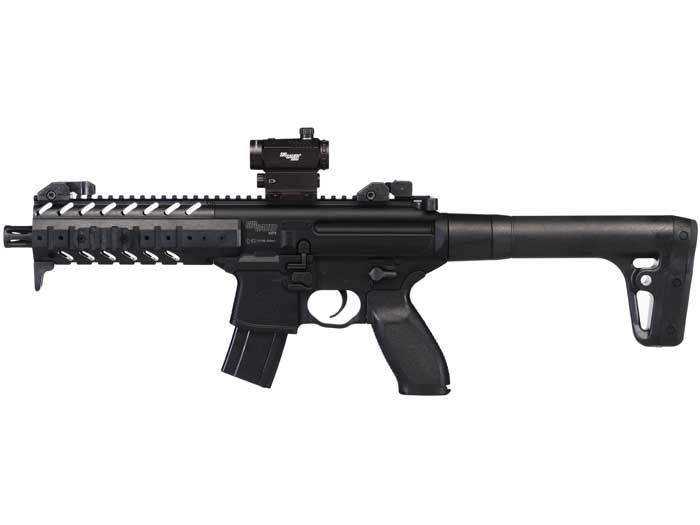
Had to think about this for a bit before I could attempt to describe how much my preconceived perception of what this gun was gonna be versus what it turned out to be.
Am I mistaken in thinking it would be offered in .22?
Maybe I thought the velocity sounded good for a .22. They should get a nice boost from going to HPA.
Reb,
Sig has retooled their launch of these airguns. They are going slower now, to avoid making any mistakes.
As for what will come, I guess that is up in the air.
B.B.
It would be nice to see how a .22 &.25 would stack up against the Marauder!
They would be lousy. Think about it. These are Joe Commando runaroundandgetshotbythecops toys. The Marauder is an air rifle.
I guess we’ll find out what this .177 can do for now but don’t discount this gun.
Well, I guess that if your objective is kill a 12 pack of feral soda cans in the back yard, this would certainly outshine a Marauder. Now if your objective is to hit a tree rat in the head at 50 yards, I’ll take the Marauder.
Fine job on the instructions. With things being made all over the world, words are often lost/translated into something altogether different and confusing. Consumer Reports highlights this in the back of their magazine. As I have said before, you are like the Consumer Reports for airgunning, fair, unbiased and factual.
As for the alloy pellets and there oft boasted ratings, no doubt the #’s are used in the FPS “wars”, but that is the first time I recall you explaining it from a liability standpoint as in how (fast) something “can” be fired from their product.
Quite innovative on the CO2 tank/shots per tank test as well. A real time saver. I like the belt-fed concept. Repeaters in general for that matter.
For the full tactical treatment airgun lovers out there, this one seems to fit the bill well.
Chris,
Not all companies acknowledge velocity as a liability, but those who have been in court certainly do. Those corporate lawyers everybody complains about earn their pay by protecting the company through its literature and advertising.
Most people are unaware of what happens behind the scenes, but I have been privileged to see it.
B.B.
B.B.,
I would think that FPE would be more of a concern. It does not matter that I could fire a tooth pick at 1000 fps. It would not go very far, be that accurate and not do much once it gets there. It seems that the more restrictive air gun laws rely on FPE instead of FPS. Interesting none the less. No doubt though, the FPS ratings are used as bragging rites and sales boosters, any liability aside.
Thanks, Chris
I’ll take you up on the toothpick doing damage!
I gotta Remington Airmaster and putting 14 pumps and a toothpick and after that it’s gonna be a Q-tip.
Back in a bit.
Back with the toothpick experiment:
It strayed right about a foot which made it hard to find and it was sticking out of the at about a 45°angle.
The Q-tip however penetrated 3 layers of 30pk cardboard before bouncing off.
Next venture will include the fancy toothpicks I could get at Sonic back in the day.
Reb,
Cool idea on the fancy toothpicks. I bet it would help to stabilize. I am looking to make something that will have some punch and be re-usable and not break. I might have to use something other than a hard target. The goal would be to get some accurate shots and then see what fpe and fps I am getting. Might be good on a soft target such as a bird. Keep me posted. The arrows really interest me, but that may not be do-able. Too much weight, too much arch in trajectory, lack of any range. ?
I think SIG knowingly exaggerated the velocity. No way does this rifle come near 600 fps with real weight not mouse weight alloy pellets
BB,
Let us start with a question about the belt system. Once you have inserted the loaded belt into the magazine, do you need to rotate it to the top to begin there or are the ends close enough when completely inserted that it operates as though it is continuous?
I think Sig is sitting on a gold mine with this magazine system. The licensing alone could make a pile. Very likely in the near future we will be seeing a plethora of replica air rifles using this. Think M-16/M-4, AKM, M-14, M-1 Carbine, Mini-14, etc.
Now a CO2 gun has my attention.
RR,
When the belt is inside the magazine the ends are so close you cannot tell that it has a break.
I agree the MPX is surprising. I have been remembering the bad old days when Anics first gave us a racetrack of individual chambers, but this one functions smoothly and doesn’t tax the trigger pull that much.
B.B.
If it works better than the 1077 that would be a treat.
I like it too but it’s supposed to be available in HPA in a bit and if I could get one in .22 that could hang with Gunfun’s .25 Mrod for under $500 I’d start saving tomorrow
Reb
Sorry but it ain’t going to hang with Gunfun1’s .25 Mrod.
It’s got a long, long ways to go. You just don’t know what my little .25 caliber is capable of until you shoot it.
And I’m not joking I’m serious.
Bring it with you to the next Texas show! I’ll bring an extra chair and maybe B.B can help keep our tables in close proximity.
BB
That could be a plan. But I thought BB was having to reorganize that show or something.
It would need to be at least 1 to 2 feet longer to come close to having the power of the MRod. Then you will need a decent barrel.
RR
Ah but maybe a stock Mrod. Not Gunfun1’s .25 Mrod. I 100% am sure the Sig Co2 gun here can not compete with my Mrod in multiple ways. Well not even a stock Mrod.
Let’s see how it can shoot out at 50 yards let alone a 100 yards. They are in two complete different catagorys. And really should not even be compared. Both guns are meant to be used different ways. Period.
That is what I have been trying to tell Reb.
RR
Yes I know.
I was speaking theoretically of the HPA versions when and IF they offer larger calibers.
I’m not much on .177 but I invite a duel between the two guns in .177 because that’s all we have them both in.
Reb
I had several gen1 and gen 2 Mrods in all calibers. And even in a .177 caliber Mrod verses the Sig in .177 pcp if they made one or if somebody converted one to HPA. I do believe the Mrod would be the winner. I’m even going to say a Discovery in .177 should out perform it.
But I’ll give the benifit of doubt. I have seen stranger things happen. Maybe and a big maybe a HPA Sig might just show its stuff and be accurate. And maybe it will get 900 fps with a 10 grain .177 pellet. And maybe shoot 3/4″ groups at 50 yards. If the Sig could do all that plus shoot 30 pellets semi-auto. Then yes that would be a heck of a gun.
I still think you are going to need about six spare magazines, a vest with pockets to carry them…
😉
I was actually thinking more in the lines of this pistol version vs the Crosman 1077 and the carbine version vs the Mrod.
🙁
Reb
1077 and Sig is cool.
Carbine verses Mrod. Just don’t know about that either.
But I’m waiting and wanting to be surprised though.
I think after those two comparisons we’d have a pretty good idea of what it can and cannot do.
Reb
Let’s just wait and see what BB gets when he does the accuracy test on the Sig.
Then we can post a link of the 1077 test and compare.
The carbine still won’t be up to it. CO2 usually maxes out at less than 700 FPS, no matter how long the barrel is. I remember BB talking about such things a good while back and he stated IHHO that the maximum optimum length for a CO2 barrel was about 16″. The CO2 molecule is large and the gas expands at a slower rate than plain old ordinary air.
Minor nit pick on your second paragraph of “Evaluation So Far”
I find that the gun meets its advertised velocity specification on the nose. Read the report to understand all that entails. I find the magazine easy to load, once you acquire the knack. the manual is poor in this area, butt the directions I have given here should make things clear.
You have an extra t in the word but of the last sentence.
Nice semi-automatic air rifle. I wonder how much velocity will be gained in the MCX version which has a 16″ barrel compared to the MPX which has an 8″ barrel. I would expect it to be quieter too. Hmm…MPX=Machine Pistol X? MCX=Machine Carbine X?
Siraniko,
Nice catch! I apparently also didn’t capitalize the first word in a sentence.
As far as I know, your definition of MPX and MCX is correct.
B.B.
BB,
For some reason every time I use your version of “but” spell check converts it to either “buns” or “bootie.”
How can this be? Is SIG somehow at fault here?
Yeah, and I thought it was just a dumb phone thing.
Neat, but as I feared it is a double action not a semi.
I understand conserving co2, but both could have been done with an electric method of advancing the belt.
The issue there is you start to have a more complicated and therefore more expensive system. You also risk the presence of Murphy. What should always be done when at all possible is to remember the Law of Simplicity; K.I.S.S.
KISS does not require anyone to claim a double action is a semiautomatic.
I now see your point about BB stating it is a semi. It is just that when you mentioned electric advancement and such, a picture of that Evanix monstrosity popped into my head, a huge, bulky, expensive curiosity.
Could they make it semi with CO2? Yes. I will bet money they even tried. I will also bet that as you stated, it had a very poor shot count.
Though many of us, including myself, prefer a semi, a revolver is much more reliable. I know, you were probably thinking of jacking around with it and make it rock and roll.
It is a very difficult issue to accomplish. I have seen one that used a similar belt as this. I have also seen one that used “cartridges” to hold the pellets. I thought that one was very promising, but I could also see where it could be very tedious trying to pick all of those little things, especially if you were moving around and shooting as you know you would.
Got the dot sight dialed in pretty well for tonight, had to stop to refill mags and put the first one in the 10!
The following 4 were all about 1/4″ from it so I’m satisfied with the results for now.
Apparently I got the dot sight set for off the curve.
I just put a fresh cartridge in and it’s hitting about1″ high.
Oh well! That gives me a project for this afternoon
We’re supposed to be up to 76 before dusk.
The Daisy electronic point sight on the 1077 is a Killer combination! I finished the mag on it this morning and got another 10 with the rest all being 9’s.
Late to comment, but another excellent review of what, so far, seems a fun shooter. RC
As always BB, a pleasure to read your reviews and astute comments and revelations. Keep up the good work writing and great photographs.
Then again, I know you too well.
Reb- I put a red dot sight on my 1077. It was not visible enough in bright sunlight. I bought a second 1077 and put a green dot sight on it. It was too bright in dim light. Then I looked at my .22 co2 Sheridan. It had a huge variable scope on it, but I only used the lowest power. I picked up Tasco 2.5 scope at a gun show. I liked it so much that I put Tasco 2.5 x20 scopes on both 1077,s and on my 2 Slavia 618,s. I like dot sights on pistols that I shoot at indoor ranges, but I prefer low power scopes for my plinking rifles. Ed
BB,
You mentioned in the Air Venturi ISSC M22 post that plastics in modern firearms make thwm function more reliably. Can you elaborate?
Thanks
Ton,
Sure. First and foremost, engineering plastic (like Delrin) has built-in lubricity. A low coefficient of friction. Guns made with it require little or no lubrication. Steel guns need lubrication — some more than others. A 1911, for example, if built for accuracy, needs lots of lube to keep it running. That’s why the government 1911s are so sloppy. Open tolerances mean less need for oil.
I was shooting a Garand a few years ago that started jamming on the range. First time that ever happened to me. When I examined the bolt I saw it was bone dry. I pulled the dipstick from my truck’s engine and lubed the bolt and the receiver and the rifle resumed flawless operation.
Secondly a plastic gun tends not to rust — at least in the plastic parts. In some environments that is extremely important.
There are other benefits, such as the tolerance to calcium-based sand (think middle east), but they are farther down on the list. Lubrication is number one.
B.B.
That belt fed mechanism is pretty cool. The gun may slow down when firing, but at least it doesn’t melt chamber flags! By the way, I’ve figured out what happened with my AK. The culprit is the inability to lock the bolt back. Even when firing a gun much faster, having air flow through the chamber must cool it down rapidly. The AK bolt shuts on the chamber. So, between that and my sustained and fairly rapid fire, it was enough to melt my chamber flag. Thanks Chris for the dowel idea which certainly won’t damage the gun.
Kenholmz, how nice of you to say. But you’re the one who posted the article. I was going to add that in conceiving of medium caliber assault rifle ammo, I don’t know if they have ever improved over the original simple idea of a full power bullet on a shortened case. The AR bullet seems to invert this idea by having a small bullet on a big case. It was an ingenious idea and it does work to an extent, but I don’t know that it is superior within the parameters of the original assault rifle design. Mikhail Kalashnikov felt the same way and didn’t believe in the smaller caliber adopted for the AK-74 in imitation of the AR.
Matt61
Matt61,
I forgot to mention those super long incense sticks. Pick the right aroma and get into the “become one with the gun” thing as the incense smoke wafts away from the heat of recent rapid fire. 😉 You might get some odd looks at the range though.
Still think it would be a more fun gun in a lower pressure HPA model.
Just a heads up… the Hammerli 850 dual 12gr CO2 conversion unit to replace the 88gr bottle will not fit on this carbine The twin 12gr CO2 adapter unit hits the stock attachment area before it screws down. The thread length it much shorter than a bottle. You would have to cut the stock attachment area off the receiver to reach the threads, but I would not try it without verifying everything else will fit and work after you do. It’s much longer and thinner than an 88gr CO2 bottle and finding something that resembles a workable stock to fit over it may be a challenge.
If the mag operation is easy on the trigger pull how about a mag with twice the capacity ?
B.B..
How ’bout it B.B?
Are we gonna have a Texas show this year?
BB, thanks for that explanation.
This may be a foolish question, but are 88 gr CO2 cartridges interchangeable with 90 gr cartridges?
They are the same cartridges. I’m not sure why they do that other than rounding off the number?